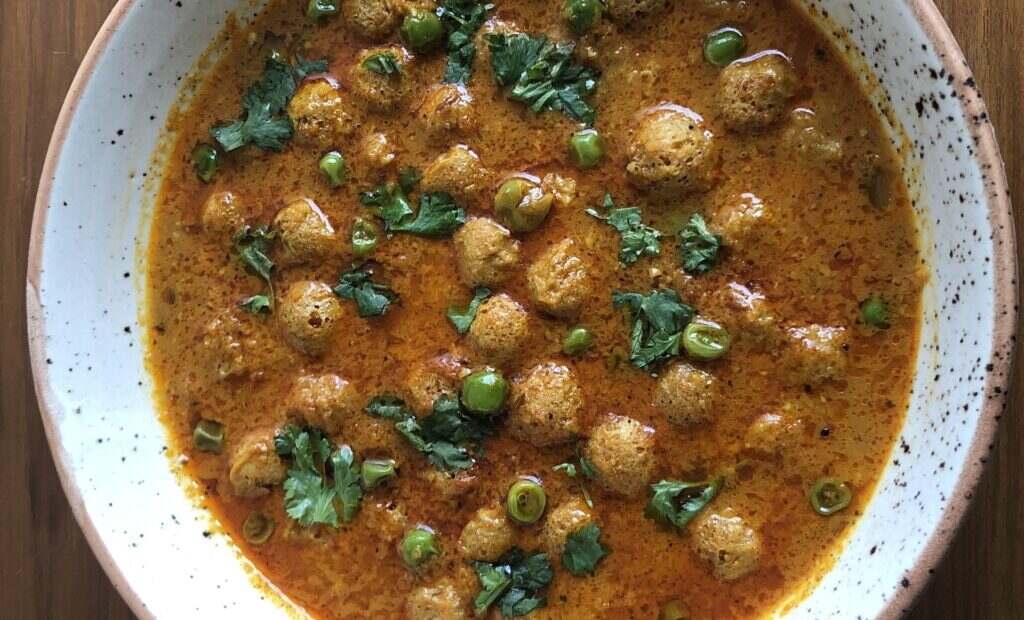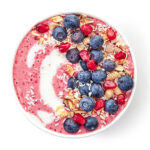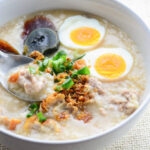Soya Chunks Curry is a flavorful and nutritious vegetarian dish made with textured vegetable protein, commonly known as soya chunks. These protein-packed nuggets are derived from soy flour and have a meaty texture, making them a popular meat substitute. The curry is typically prepared by simmering soya chunks in a fragrant blend of spices, tomatoes, onions, and other seasonings. This savory and hearty dish is not only delicious but also a great source of plant-based protein, making it a favorite among vegetarians and those looking to incorporate more protein-rich options into their diet. Soya Chunks Curry is often served with rice or Indian breads, offering a satisfying and wholesome meal.
| Ingredients | |
| 1 | 1 cup soya chunks |
| 2 | 1 large onion, finely chopped |
| 3 | 2 tomatoes, finely chopped |
| 4 | 2 green chilies, slit |
| 5 | 1/2 cup yogurt |
| 6 | 1 tablespoon ginger-garlic paste |
| 7 | 1 teaspoon cumin seeds |
| 8 | 1 teaspoon turmeric powder |
| 9 | 1 teaspoon red chili powder |
| 10 | 1 teaspoon coriander powder |
| 11 | 1/2 teaspoon garam masala |
| 12 | Salt to taste |
| 13 | Fresh coriander leaves for garnish |
| 14 | 2 tablespoons oil |
| 15 | Water for soaking and cooking soya chunks |
Step-by-step cooking instruction of Soya Chunks Curry:
Step-1 Prepare Soya Chunks:
- Boil enough water in a pot and add the soya chunks.
- Soak them for fifteen to twenty minutes, or until they get tender.
- Squeeze out the excess water from the soya chunks and set them aside.
Step-2 Cooking Soya Chunks:
- One tablespoon of oil should be heated in a pan.
- Add the soaked and squeezed soya chunks to the pan.
- Stir-fry them until they turn golden brown.
- Remove and set aside from the pan.
Step-3 Tempering:
- In the same pan, add another tablespoon of oil.
- Sprinkle in the cumin seeds and watch them pop.
- Chop the onions small and sauté them until they become golden brown.
Step-4 Add Spices:
- Add ginger-garlic paste and green chilies. Let it cook for a minute, or until the raw scent goes away.
- Add turmeric powder, red chili powder, coriander powder, and salt. Mix well.
Step-5 Tomato Base: Add finely chopped tomatoes and cook until they become soft and the oil starts to separate from the masala.
Step-6 Yogurt and Soya Chunks:
- Lower the heat and add yogurt to the masala. Stir continuously to avoid curdling.
- Add the stir-fried soya chunks and mix well to coat them with the masala.
Step-7 Simmering:
- Add garam masala and adjust the consistency with water if needed.
- Allow the curry to simmer for 10-15 minutes, letting the flavors meld together.
Step-8 Garnish and Serve:
- Garnish with fresh coriander leaves.
- Serve hot with your preferred Indian bread or rice.
Nutritional values of Soya Chunks Curry:
The nutritional value of Soya Chunks Curry can vary based on specific ingredients and portion sizes, but here’s a general overview of the key nutrients you can expect from a serving:
Nutritional Value per Serving (1 cup):
| 1 | Calories: Around 200-250 kcal |
| 2 | Protein: 15-20 grams |
| 3 | Fat: 10-15 grams |
| 4 | Carbohydrates: 15-20 grams |
| 5 | Dietary Fiber: 5-8 grams |
| 6 | Vitamins and Minerals: |
| Vitamin A | |
| Vitamin C | |
| Vitamin K | |
| B-vitamins (B1, B2, B3, B6) | |
| Folate | |
| Calcium | |
| Iron | |
| Magnesium | |
| Phosphorus | |
| Potassium | |
| Zinc |
Background History of Soya Chunks Curry:
The background history of Soya Chunks Curry is not as well-documented as some traditional dishes, but we can provide some context about the main ingredient, soya chunks, and how it became a popular component in vegetarian and vegan cuisines.
1. Introduction of Soybeans: Soybeans have been cultivated in East Asia for thousands of years, particularly in China. Soy products, such as tofu and soy sauce, have been integral parts of Asian cuisine for centuries.
2. Globalization of Soy Products: In the 20th century, soy products gained popularity worldwide due to their nutritional value and versatility. The rise of vegetarianism and veganism in various cultures contributed to the exploration of plant-based protein sources.
3. Textured Vegetable Protein (TVP): Textured Vegetable Protein (TVP) is a byproduct of soybean processing. It gained prominence as a meat substitute and protein source in the mid-20th century, especially in the context of vegetarian and vegan diets.
4. Emergence of Soya Chunks: Soya chunks, also known as soy chunks or meal maker, are derived from TVP. They are dehydrated and processed to have a meat-like texture, making them a convenient and versatile ingredient in various dishes.
5. Incorporation into Indian Cuisine: In India, soya chunks found their way into traditional cuisines, particularly in vegetarian dishes where they serve as a protein-rich substitute for meat. Soya Chunks Curry is one such adaptation, combining the global influence of soy products with the diverse and flavorful elements of Indian cooking.
6. Adoption in Vegetarian Diets: Soya Chunks Curry became popular among vegetarians and those seeking plant-based protein options. The dish offers a satisfying and nutritious alternative to meat-based curries while providing a rich source of essential amino acids.
While the exact history of Soya Chunks Curry might not be extensively documented, it reflects the broader trend of incorporating plant-based protein sources into diverse culinary traditions, catering to the evolving dietary preferences and nutritional needs of people around the world.
| Advantages of Soya Chunks Curry | |
| 1 | High Protein Content: Soya chunks are a rich source of plant-based protein, making Soya Chunks Curry an excellent choice for vegetarians and vegans looking to meet their protein needs. |
| 2 | Complete Protein Profile: Soy protein is unique among plant proteins as it contains all essential amino acids, making it a complete protein source that can contribute to overall nutritional balance. |
| 3 | Nutrient-Rich: Soya Chunks Curry often includes a variety of spices, vegetables, and other ingredients, providing a range of essential vitamins, minerals, and antioxidants. |
| 4 | Fiber Content: The dish can be a good source of dietary fiber, supporting digestive health and providing a feeling of satiety. |
| 5 | Versatility: Soya Chunks Curry is versatile and can be customized with different spices and vegetables, allowing for a variety of flavors and textures. |
| 6 | Meat Substitute: Soya chunks have a meaty texture, making them a popular substitute for meat in various dishes, appealing to those seeking plant-based alternatives. |
| 7 | Cholesterol-Free: Soy products, including soya chunks, are naturally cholesterol-free, which can be beneficial for heart health. |
| 8 | Suitable for Various Diets: Soya Chunks Curry is suitable for different dietary preferences, including vegetarian, vegan, and those looking to reduce meat consumption. |
| Disadvantages of Soya Chunks Curry | |
| 1 | Allergies: Some individuals may be allergic to soy products, and consumption can lead to allergic reactions. It’s essential to be aware of any allergies before incorporating soya chunks into the diet. |
| 2 | Processing Concerns: Commercially available soya chunks may undergo processing that involves additives or preservatives. Checking ingredient labels can help in choosing minimally processed options. |
| 3 | Anti-Nutrients: Soy contains compounds known as anti-nutrients, such as phytates, which can inhibit the absorption of certain minerals. Soaking and cooking soya chunks can help mitigate this effect. |
| 4 | Genetically Modified Organisms (GMOs): Some soy products, including soya chunks, may be derived from genetically modified soybeans. Choosing non-GMO or organic options can address this concern. |
| 5 | Thyroid Function: There is a debate about the potential impact of soy on thyroid function due to its goitrogenic properties. However, moderate consumption is generally considered safe for most individuals. |
| 6 | Flatulence: Soybeans contain complex carbohydrates that can lead to gas or bloating in some individuals. Proper cooking techniques, such as soaking, can help reduce these effects. |
| 7 | Texture and Taste: While soya chunks provide a meaty texture, some people may find the taste and texture less appealing than traditional meat. |
Compare with Similar meal of Soya Chunks Curry:
If you enjoy Soya Chunks Curry, you might also like these similar plant-based meals that feature protein-rich ingredients and flavorful spices:
| 1 | Soya Keema: A minced soya preparation cooked with onions, tomatoes, and a blend of aromatic spices, resembling the texture and flavor of keema (minced meat). |
| 2 | Chana Masala: A classic Indian dish made with chickpeas (chana), cooked in a spicy and flavorful tomato-based gravy with a variety of spices. |
| 3 | Dal Makhani: A creamy and hearty lentil dish made with black urad dal and kidney beans, simmered in a rich tomato-based sauce with butter and cream. |
| 4 | Rajma Masala: Red kidney beans (rajma) cooked in a thick and spicy tomato-based gravy with onions, garlic, and a blend of aromatic spices. |
| 5 | Paneer Butter Masala: Soft paneer cubes cooked in a creamy and flavorful tomato-based gravy with a medley of spices, creating a rich and satisfying dish. |
| 6 | Palak Tofu: Tofu cubes cooked in a spinach-based gravy with spices, creating a nutritious and delicious meal that’s high in protein. |
| 7 | Vegetable Biryani: Fragrant basmati rice cooked with mixed vegetables, spices, and sometimes tofu or paneer for added protein, creating a flavorful one-pot meal. |
| 8 | Soy Kofta Curry: Soy koftas (round or oval-shaped balls made with soya granules) served in a spiced tomato-based curry, offering a different texture and presentation. |
| 9 | Aloo Gobi: Cauliflower and potatoes (aloo) cooked with spices like cumin, turmeric, and coriander, creating a simple yet flavorful dry curry. |
| 10 | Vegetable Kurma: A South Indian dish featuring a mix of vegetables cooked in a coconut-based gravy with aromatic spices, providing a rich and comforting meal. |
Mostly questions asked about Soya Chunks Curry
Q: What are soya chunks, and how are they made?
A: Soya chunks are textured vegetable protein made from soy flour. They are produced by defatting soy flour and then extruding it into various shapes, giving them a meat-like texture.
Q: Are soya chunks a good source of protein?
A: Yes, soya chunks are an excellent source of plant-based protein. They are a complete protein source because they contain all of the essential amino acids.
Q: How do I cook soya chunks before adding them to the curry?
A: Soya chunks need to be soaked in hot water for about 15-20 minutes to rehydrate. Squeeze out excess water before adding them to the curry.
Q: Can I use soya chunks in other dishes besides curry?
A: Absolutely! Soya chunks are versatile and can be used in various dishes, including stir-fries, soups, stews, and keema-style preparations.
Q: Are there variations of Soya Chunks Curry in different cuisines?
A: Yes, different cuisines may have variations of soya chunks curry, incorporating regional spices and flavors to suit local tastes.
Q: Are soya chunks suitable for a vegan diet?
A: Yes, soya chunks are plant-based and suitable for vegans. They are a popular choice as a meat substitute in vegan and vegetarian recipes.
Q: How can I enhance the flavor of Soya Chunks Curry?
A: Experiment with aromatic spices like cumin, coriander, garam masala, and fenugreek. Adding fresh herbs, like cilantro, and a splash of lemon juice can also enhance the flavor.
Q: Can I freeze Soya Chunks Curry for later consumption?
A: Yes, Soya Chunks Curry can be frozen. Allow it to cool, and then transfer it to an airtight container before freezing. Thaw and reheat just before serving.
Q: Are there any health concerns related to consuming soya chunks?
A: For the most part, soy chunks are regarded as safe. However, individuals with soy allergies or certain medical conditions should consult a healthcare professional.
Q: How can I make Soya Chunks Curry less spicy for a milder taste?
A: Adjust the quantity of red chili powder and green chilies according to your spice preference. You can also add a dollop of yogurt to mellow down the heat.







